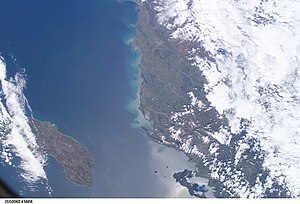
Albania is a country in Southeastern Europe that lies along the Adriatic and Ionian Seas, with a coastline spanning approximately 476 km (296 mi). Situated on the Balkan Peninsula, it is one of the most mountainous countries in Europe. It is bounded by Montenegro to the northwest, Kosovo to the northeast, North Macedonia to the east and Greece to the southeast and south.

Vlorë is the third most populous city of the Republic of Albania and seat of Vlorë County and Vlorë Municipality. Located in southwestern Albania, Vlorë sprawls on the Bay of Vlorë and is surrounded by the foothills of the Ceraunian Mountains along the Albanian Adriatic and Ionian Sea Coasts. It experiences a Mediterranean climate, which is affected by the Ceraunian Mountains and the proximity to the Mediterranean Sea.

Sazan is an Albanian uninhabited island in the Mediterranean Sea. The largest of Albania's islands, it is a designated military exclusion zone; it lies in a strategically important location between the Strait of Otranto and the mouth of the Bay of Vlorë, marking the border between the Adriatic and Ionian seas.

Vlorë County is one of the 12 counties of the Republic of Albania with the capital in Vlorë. The county spans 2,706 square kilometres (1,045 sq mi) and has a total population of 187,675 people as of 2021. It borders the counties of Fier and Gjirokastër, as well as the Adriatic and Ionian Sea.

Himarë is a municipality and region in Vlorë County, southern Albania. The municipality has a total area of 571.94 km2 (220.83 sq mi) and consists of the administrative units of Himarë, Horë-Vranisht and Lukovë. It lies between the Ceraunian Mountains and the Albanian Ionian Sea Coast and is part of the Albanian Riviera. The traditionally perceived borders of the Himarë region gradually shrank during the Ottoman period, being reduced to the town of Himarë and the villages of the coastline, generally including only Palasë, Dhërmi, Pilur, Kudhës, Vuno, Iljas and Qeparo.
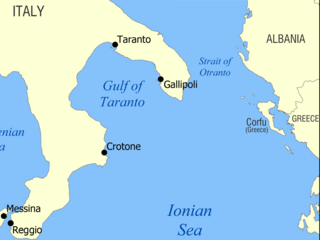
The Strait of Otranto connects the Adriatic Sea with the Ionian Sea and separates Italy from Albania. Its width at Punta Palascìa, east of Salento is less than 72 km. The strait is named after the Italian city of Otranto.

The Vlora War was a military conflict in the Vlorë region of Albania between the Kingdom of Italy and Albanian nationalists. The war ended with Albanian nationalists forcing Italy to abandon its plans to make Albania a mandate, and ceding Vlorë to Albania. Italy retained diplomatic protection over Albania to ensure its independence, while annexing the island of Saseno. The armistice agreement was ratified a year later by the Conference of Ambassadors of the League of Nations. The Vlora War is considered an important moment in the history of Albanian independence.
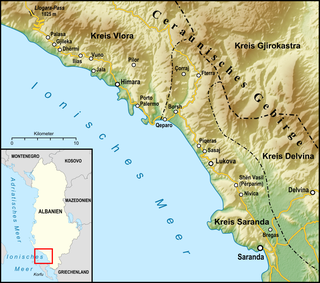
The Albanian Riviera, also popularly known as Bregu, is a coastline along the north-eastern Ionian Sea in the Mediterranean Sea, encompassing the districts of Sarandë and Vlorë in south-western Albania. It forms an important section of the Albanian Ionian Sea Coast, dotted with the villages of Palasë, Dhërmi, Vuno, Himara, Qeparo, Borsh, Piqeras, Lukovë, and the city of Sarandë.
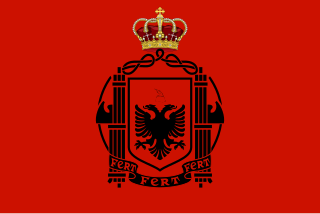
The Italian colonists in Albania were Italians who, between the two World Wars, moved to Albania to colonize the Balkan country for the Kingdom of Italy.
Ansi Nika is an Albanian professional footballer who plays as a midfielder for Albanian club Flamurtari Vlorë.
Border crossings in the Republic of Albania are defined as boundary checkpoints that serve to control the flow of people and goods from neighbouring countries to and from Albania. These checkpoints are administered by the border police authorities that record the entry and exit of each person and vehicle followed by the customs authorities that record the entry and exit of goods and cash. Albania currently has 22 operational land border crossings and shares borders with Montenegro, Kosovo, North Macedonia, and Greece. This article outlines a complete list of Albania's international border crossings, including land, sea and air entry points.

Vuno is a village in the municipality of Himarë, Vlorë County, Albania. It is located on the road that connects the centre of Himarë with the village of Dhërmi on the Albanian Riviera. The population of Vuno is exclusively Orthodox Albanians.

The Karaburun Peninsula is a peninsula of the Mediterranean Sea located in Southern and Southeastern Europe, which is almost completely surrounded by both the Adriatic Sea to the north and the Ionian Sea to the south. It is located in Southwestern Albania along the Albanian Ionian Sea Coast, whereas the Strait of Otranto separates it from Italy. The Strait of Mezokanal separates the peninsula from Sazan Island, while in the southeast stretches the Bay of Vlorë. Its name “Karaburun” derives from Turkish for "black cape". In classical antiquity, its name was the "Akrokeraunian Peninsula", whose name was derived from the eponymous Akrokeraunian mountains;this is because, in terms of geology, the Rrëza e Kanalit on the peninsula represent the continuation of said mountains, which are the highest and most extensive mountain range system that extends parallel to the Ionian Sea. Karaburun peninsula is sometimes called Ceraunian Peninsula due to the name of the mountain range. Created during the mesozoic era of the cretaceous and paleogene period, the crests of the mountain range form a northwest-southeast line with a series of distinct peaks along its irregular structure that are broken apart by steep and unequally slopes. The highest peaks are namely, the Maja Çaderës, Maja e Flamurit, Maja e Koretës and Maja e Ilqes.

Bujar Faik Nishani was an Albanian politician. He served as the president of Albania from 24 July 2012 to 24 July 2017.

Karaburun-Sazan Marine Park is a marine park in the Vlorë County of southwestern Albania. The marine park encompasses over 125.70 km2 (48.53 sq mi) and comprises the boundaries of both the Peninsula of Karaburun and the Island of Sazan. It is home to a vast array of landforms, including mountains, caves, islands, depressions, bays, cliffs, canyons and rocky coasts, all contributing to an exceptionally considerable biological diversity. The marine park has been identified as an Important Bird and Plant Area, because it supports immense bird and plant species. Containing ecosystems and habitats that are specific to the Mediterranean Basin, the convention of Barcelona has classified the marine park as a Specially Protected Areas of Mediterranean Importance.
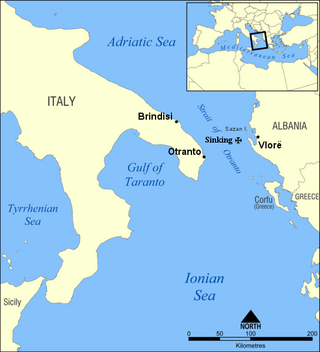
The Tragedy of Otranto took place on 28 March 1997 when the Albanian ship Kateri i Radës sank in a collision with the Italian corvette Sibilla (F 558) in the Strait of Otranto and at least 84 Albanians, aged 3 months to 69 years, lost their lives. The emigrants had been part of a large migration of Albanians to Italy during the 1997 Albanian civil unrest, that began after the collapse of several large-scale pyramid schemes. To prevent the unauthorized entry of migrants into Italy, the Italian Navy set up a procedure to board Albanian vessels whenever encountered, implementing a de facto blockade.
The 2014–15 season was Klubi i Futbollit Tirana's 76th competitive season, 76th consecutive season in the Kategoria Superiore and 94th year in existence as a football club.
Argjend Malaj is a Kosovar-Albanian professional footballer who plays as a central midfielder for Swedish side Trollhättan.

The Albanian Ionian Sea Coast is a coastline of the north-eastern Ionian Sea, that encompasses the south-western border of the Republic of Albania, stretching from the southern half of Karaburun Peninsula, across the historical region of Labëria, the city of Sarandë, the mountains of the Ceraunians, and the Albanian Riviera, to the Lake of Butrint, where the Strait of Corfu separates the country from Greece.
In the 2015–16 season, Partizani Tirana competed in the Kategoria Superiore for the third consecutive season. The club finished second at the end of the season, which was their best result since 2008.
